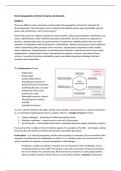Notes Geographies of Food: lectures and tutorials
Lecture 1
There are different actors and layers involved within the geographies of food. For example, the
Boerenprotesten. The food system also is related to the political system and sustainability. How do
power and control play a role in food systems?
Power and control are integral components of food systems, influencing production, distribution, and
access. Agribusinesses, often wielded by powerful corporations, exercise control over agricultural
practices, shaping what crops are grown and how. Governments establish policies that can either
empower or marginalize small-scale farmers. In distribution, retailers and processors exert significant
control, determining which products reach consumers. Socioeconomic disparities further amplify
power imbalances, impacting access to nutritious food. Moreover, cultural and social norms can be
manipulated to control dietary choices. Recognizing the dynamics of power and control in food
systems is crucial for fostering sustainability, equity, and addressing global challenges like food
insecurity and malnutrition.
The 6 dimensions of food:
- Public good
- Human right
- Cultural determinant
- Tradeable good; generate
financial income (commodity –
something that has a use and
commercial value, trade,
produced for sale).
- Renewable resource; natural
thing that grows, harvest
annually
- Essential for humans
You see a division between the upper and the lower people; some see food as a common and others
as a commodity (tradable good). Food is complex. There is a triangle of issues for food:
1. Supply challenges – production of sufficient nutritious food
2. Planetary challenges – natural resource use and its boundaries
3. Social injustice – social/political dimension, inequalities between people and places, tensions
Food and nutrition is high on the international agenda, for example on the SDG – end hunger, achieve
food security and improved nutrition and promote sustainable agriculture.
Food system – it is a broad perspective; holistic and everything is connected. Focus on feedback links,
change in one dimension has implications for others. It is a complex system, too many factors and
actors to predict its outcome. Increased recognition of interlinkages.
Production, ecology and society is covered. You are interested in the interlinkages, how is
everything related to each other? Production, trade and consumption of food are printed in
the human history for centuries long. We went from local systems to more global systems.
The local system consists of local resources, community activities, commons, subsistence
, farming, division of labour and specialization, local trade markets and seasonal produce. The
global system is about the disembedding of the system (cutting links, out of the original
context). Distancing from the local. We see food now as a commodity and its produced for
the global market. It is led by corporations within the global food system. Its more about the
economic interest instead of a practical uses.
Food network – a more limited version of the food system.
Supply chain – all actors and steps from field to fork. Supply chain is a logistical perspective, value
chain is more focused on the power system, and economic/social factors.
The current global food system is very complicated. There is a difference between the environment
and indirect drivers behind the system. Many factors and actors play a role.
Characteristics of the Global Food system:
1. Complexity – complex systems. The outcomes cannot be predicted because there are too
many factors and feedback loops.
2. Geographical configurations – specialization and division of labor around the globe. Based on
nature, but also on history and
politics
3. Power configurations –
regulation and finance.
Globalization made finance a
key determinant in business,
and rules reflect historical
legacies
The colonial heritage plays still a
fundamental role in the food system,
it’s a story about the European
expansion. Therefore there was
unequal development and different
food regimes. A core/periphery
, hierarchy emerged, with different societies within it. The current Global Food System and its
geographies is not simply just there, it is originated in the power relations, history and finance.
Early globalization and colonial experience of food was the Colombian Exchange among Europe,
North-America and Africa. There were some (unintended) consequences for Senegal for example.
Corporations take the lead within the food system. Multinational companies and brands sells and
produce, the lobby and are relatively more powerful. If you dominate the supply of a certain product,
you have a strong position. Inequalities within countries/regions are now more emerging than the
inequalities between countries.
Complexities in the understandings of food health and unhealth. Healthy food is different in everyone
perspectives. Sustainability, and social-cultural perspectives are not really covered in the health circle.
Food on your plate – nutrition-based meanings of healthy food are related to the process of food
medicalization, in which food and its practices are understood and experienced through a medical
point of view, based on scientific nutritional rationality.
Food as a practice – socio-culturally-informed meanings of healthy food includes the pleasure derived
from the acts of sharing food experiences that positively contributes to consumers’ overall pleasure
and satisfaction with consumer’s food consumption.
Food-health associations are also created in particular contexts by the social actors present in those
given contexts, interacting with the values, representations, practices and norms that organize social
life.
- Relief – potatoes are healthy food to me. Potatoes have a very cultural significance in Peru.
We are proud of our potatoes. Potatoes have long maintained a lot of civilizations in Peru.
High up in the Andes people ate potatoes to stay warm and that is an aspect of health which I
find in potatoes.
- Seasons – this one you see on the photo is not necessarily healthy in nutrition sense as it is
deep fried. However, I consider it healthy because of the feeling it gives when you eat it. This
is often eaten during winter time in Northern India as brunch or breakfast food. So, it is a
little bit heavy food to keep you warm and going during the cold winters. To me, that is
healthy.




